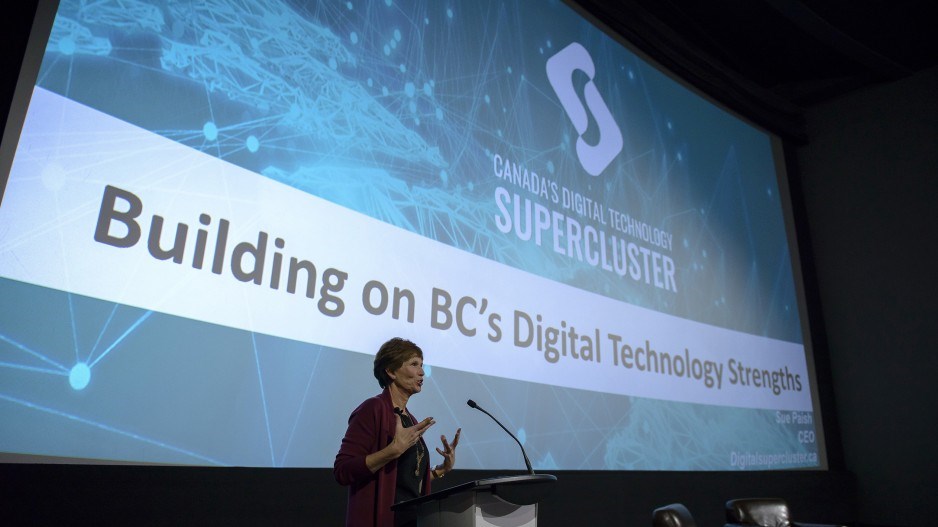As the Digital Technology Supercluster (DTS) initiative gets underway in Vancouver, CEO Sue Paish has a message for the 571 organizations that have jumped on board over the past 18 months:
“This is not a program where you have a good idea, you bring it forward, you put a proposal in, you get some funding and then we say, ‘Have a good day. I hope it works out,’” Paish told a Greater Vancouver Board of Trade (GVBOT) audience packed into a downtown movie theatre November 13. “We must see outcomes that are commercially viable.”
But the commercialization quest for the DTS, which aims to stoke industry and post-secondary collaborations on digital products, could be placing a disproportionate burden on smaller players signing up, according to one expert.
Five supercluster programs across the country are sharing $950 million in federal funding to create public-private partnerships in regions with business activity primed for collaboration.
Telus Corp. (TSX:T), Microsoft Corp. (Nasdaq:MSFT) and the University of British Columbia were among the 60 organizations that participated in the initial bid for funding in 2017.
“There are some challenges in how the incentives and constraints of smaller ventures … are being considered,” said Elicia Maine, an innovation and entrepreneurship professor at Simon Fraser University’s Beedie School of Business.
Participants are required to make investments in collaborative projects pitched to the DTS. Each project must include a minimum of three organizations, at least one of which must be a small- or medium-sized enterprise (SME).
Maine said this requirement places a greater burden on SMEs that may not be able to justify the risk of the investment, which could in turn filter out certain projects from applying for supercluster funding.
“There should be a distinct [funding] bucket that does not have that constraint,” said Maine, who is also the academic director of Beedie’s Invention to Innovation program.
“You’re having them [SMEs] pay several tens of thousands of dollars – at least – and they don’t know if they’re going to end up having anything to show for that in terms of bringing forth their ideas.”
While anchor companies can afford to make the upfront investments, they are not the organizations known for breakthrough innovations, which is why SME participation is desired for a successful supercluster, according to Maine.
She said adding a separate funding pool that does away with the requirement for upfront investments will ensure more fairness for the SMEs.
“Participants manage their own cash flow with regards to their project in accordance with a project agreement,” Paish said in an email to Business in Vancouver.
“The digital supercluster will monitor and manage the use of the funds for the project, including the federal investment of all participants. Each project is a consortium of businesses, which includes SMEs and will work with other project partners to ensure its success.”
Maine, who praised Paish’s selection as CEO, said the supercluster still offers an opportunity to build a potent industry ecosystem where B.C. already has strength while tapping into emerging sectors where there’s greater potential.
But she added it’s important for the supercluster to feature a wide range of players at different stages if it is to be successful.
While the DTS is still in its infancy, growth has been swift since Ottawa selected five bids for nearly $1 billion in funding in February.
The B.C.-led initiative, which Paish describes as a national program, has more than doubled the number of participating organizations since the year began, to 571 from 260.
A November 2017 executive summary estimated that participants could eventually invest $1.4 billion to fund 100 collaborations involving 1,000 organizations over a decade.
Paish told the GVBOT audience that organizations should expect a competitive selection process for bids seeking reimbursement funding.
As industry and post-secondary collaborators hit milestones for projects the DTS signs off on, the DTS in turn invests about $0.75 for every dollar of private-sector investment.
Participants must invest money before the DTS does.
“This is a collaborative consortia-based initiative,” Paish said. “It’s not funding a single organization’s strategic plan or idea.”




